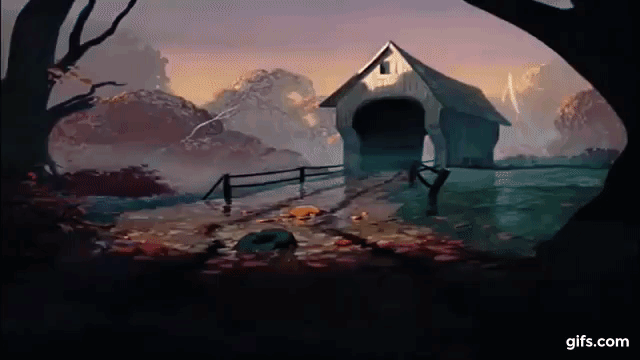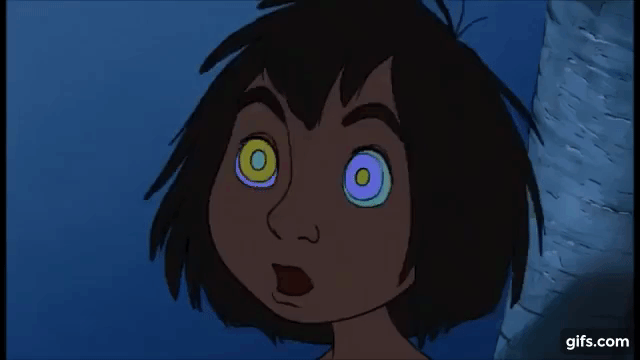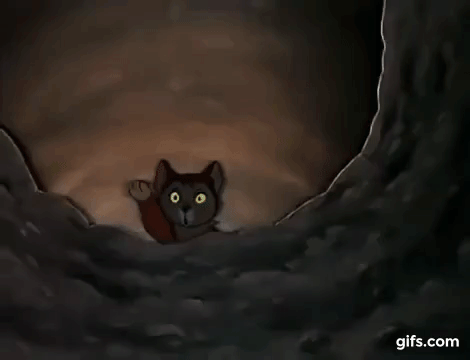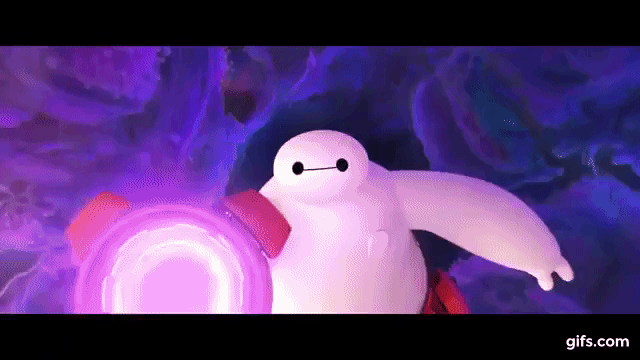The 80 Greatest Shots in Disney Animation History [Part Three]

(Welcome to The Greatest Shots in Disney Animation History, a limited series where Disney expert Josh Spiegel selects and ranks the defining moments in one of the greatest, most important, and most influential collections of films ever made.)
This part of the ongoing list covers entries 60 through 51.

60. The Adventures of Ichabod and Mr. Toad: Motor mania
Mr. Toad, when The Adventures of Ichabod and Mr. Toad begins, wouldn’t know a car from a hole in the ground. But once he sees a car up close and personal, he digs them. Like, he really loves them. He’s flat-out crazy for them, as we see in an incredible piece of character animation shown in this shot. Toad has, as the narrator dubs it, motor mania, and it’s reflected in his saucer-like eyes, spinning with possibility and color. Coming before the adaptation of The Legend of Sleepy Hollow, this section, adapting The Wind in the Willows, isn’t quite as remarkable (at least because, unlike the theme-park ride inspired by the film, this doesn’t literally end with Toad in Hell). But the representation of how quickly he becomes fascinated by cars accomplishes so much storytelling without a single word being spoken.

59. The Adventures of Ichabod and Mr. Toad: The remnants of the headless horseman
Is the Headless Horseman real? What really happened to Ichabod Crane after a spooky Halloween party and potential encounter with a ghoul? We’ll never know, as the conclusion of The Adventures of Ichabod and Mr. Toad leaves that deliberately unknown. Instead, one of the final shots of the 1949 package film is that of the remnants of the Headless Horseman, or just some debris kicked up during a windy night. The majority of this section of the film captures in beautiful fashion the sight of a small town in upstate New York, but the shot of the now-abandoned road and the possibility that a true ghost was just terrorizing a dweeby headmaster is a truly scary finale.

58. The Many Adventures of Winnie the Pooh: Pooh with a nightmarish honey pot
The Many Adventures of Winnie the Pooh is one of the last package films in the Disney Animation canon, largely stitched together from three short films featuring the characters of the Hundred Acre Wood. The 1977 feature, like the shorts, boasts some wonderful music courtesy of the Sherman brothers. Aside from the song all about Winnie the Pooh himself, it’s “Heffalumps and Woozles” that might be most memorable. The sequence accompanying this song is a nightmare Pooh has about the eponymous creatures and their unquenchable thirst for the honey he loves so very much. “Heffalumps and Woozles” is animated with the same heedless abandon and wild style as the “Pink Elephants on Parade” sequence of Dumbo, in part because the rest of Winnie the Pooh is so placid and friendly. The shot here, of Pooh holding a honey pot only to see it stolen by the titular creatures, is just one glimpse of how weird and daffy this sequence is.

57. The Jungle Book: Mowgli under Kaa’s spell
The Jungle Book is one of the more lushly animated films of the Xerographic era of Disney Animation. The 1967 adaptation of Rudyard Kipling’s stories of the man-cub in the Indian jungle isn’t terribly interested in photorealism or accuracy, but it still brings to life the dark-green jungle in striking, beautiful strokes. And sometimes, it delves into the fantastical, as when man-cub Mowgli is temporarily waylaid by the seductive snake Kaa, voiced by Sterling Holloway. Kaa has the kind of gaze that’ll hook you in if you don’t look away, so he can squeeze the life out of you and devour you whole. It nearly happens to Mowgli, captured in this shot where his eyes go into a colorful fantasia that communicates to us how hypnotized he is by the strange, slithering snake.

56. Robin Hood: Robin and Maid Marian in love
Robin Hood has a cult fanbase, but even some of its fans are willing to acknowledge that part of the film’s legacy is tarnished. That’s because Disney’s animators, due to budgetary needs, went back to the drawing board with some of the sequences in this film. By that, I mean that there are literally scenes in this film that are traced over from earlier Disney films. However, the film’s best sequence has some unique and distinctive animation, and arguably set alight the hearts of many viewers who now are unashamed when acknowledging the attraction they felt to the anthropomorphized fox versions of Robin Hood and Maid Marian. “Love” is a song that plays over the frolicking and playing of the two leads as they enjoy some alone time together, with extreme close-ups of both Robin and Marian that almost prove why the copied-over scenes are so frustrating. When Disney’s animators were able to animate new characters, they did so with flair. Robin and Marian burst with emotion in this shot/reverse shot, their eyes communicating so much that words can’t.

55. Alice in Wonderland: Dinah waving goodbye to Alice
Alice is a flighty child, much more interested in her daydreams than hearing her sister drone on about supposedly important topics. After briefly imagining what she thinks would be her perfect world, she and her cat Dinah see something truly impossible: a talking, singing white rabbit with a waistcoat and a watch. Alice can’t help but be curious, and falls down into the rabbit hole. Before she truly enters Wonderland, Alice’s last look is to her cat, Dinah, who waves goodbye to her as she tumbles down further and further. The plaintive look on Dinah’s face as she waves a paw at Alice is both funny and a sign that the story coming up is particularly crazy.

54. Winnie the Pooh: Pooh in the hallucinatory swimming pool of honey
Just as the 1977 film featuring Winnie the Pooh and his friends from the Hundred Acre Wood gets a wee bit hallucinatory when Pooh is thinking about the honey, the same is true of the 2011 film bearing the bear’s name. This wonderful, underrated gem boasts a number of new songs, written by Robert Lopez and Kristen Anderson-Lopez, including one that’s all about Pooh’s favorite food. “Everything Is Honey” is a song that becomes about as literal as possible, as Pooh imagines swimming in an endless supply of honey, eating as much as he can, even gobbling up a Pooh-shaped version of the treat. This shot of Pooh doing his best Esther Williams isn’t quite as nutty as the bit in the original with heffalumps and woozles, but it’s a blindingly bright bit of animation that encapsulates Pooh to a T.

53. The Rescuers Down Under: The opening
The forgotten film of the Disney Renaissance, The Rescuers Down Under is an odd duck to say the least. Its most exciting moments come in the first minutes, before the eponymous heroic mice are even introduced. But even before the young boy who gets kidnapped to kickstart the plot is introduced, we get a thrilling case study of what computer animation might be able to accomplish. Before Pixar Animation Studios was…well, Pixar, they’d helped innovate CAPS, or the Computer Animation Production System, utilized to thrilling effect in the opening-credits sequence of this 1990 sequel. The technology is fairly simple — it’s just a fast-paced shot tracking through the Australian Outback. But 30 years ago, the wizardry was incredible to behold.

52. The Great Mouse Detective: Ratigan goes nuts
Ratigan is a truly underrated Disney villain. Voiced by the mellifluous horror-film icon Vincent Price, Professor Ratigan is the Moriarty to Basil of Baker Street’s Sherlock Holmes, and genuinely complex: he’s a rat who so badly wants to be a mouse that he kills anyone who says otherwise. At the climax of this 1986 film, Ratigan has attempted to take captive the winsome young mouse Olivia in the inner workings of Big Ben itself. But Basil is once again to the rescue, grabbing Olivia away from Ratigan as they try to escape. In case we weren’t already clear on Ratigan’s villainy, there’s this terrifying shot of Ratigan losing his mind without having to utter a word. The character animation bringing to life this break from sanity is as chilling as anything Price says.

51. Big Hero 6: Baymax lets go
It is, by now, more than a small cliche for characters to appear to be dead in Disney films, only to be revived by the end. It’s also become something of a cliche in the Marvel Cinematic Universe. So when these two studios crossed over with the 2014 animated film Big Hero 6, it was perhaps no surprise that the familiar trope got trotted out once more. The story of Hiro, a preternaturally intelligent teenager who uses his dead brother’s health-care robot to become a superhero of sorts, is made all the more impactful because of that robot, who is named Baymax. Baymax becomes a surrogate family member to Hiro, thus making its sacrifice in the finale — enabling Hiro to escape a neon-colored purgatory — both touching and unsurprising. (Would you believe that Baymax is rebuilt before the end?) The shot of Baymax letting go in this void, as Hiro, heartbroken, is sent back to the real world, is heartbreaking enough to almost make you think this death would stick.
***
The fourth entry in this series arrives tomorrow. Stay tuned!
The post The 80 Greatest Shots in Disney Animation History [Part Three] appeared first on /Film.
from /Film https://ift.tt/3kqEFgc